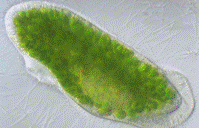Biological Sciences, School of

School of Biological Sciences: Faculty Publications
Document Type
Article
Date of this Version
2001
Citation
Published in Environmental Science & Technology 35:8 (2001), pp. 1644–1650; doi: 10.1021/es0016598
Abstract
The potential for microbially catalyzed NO3—-dependent oxidation of solid-phase Fe(II) compounds was examined using a previously described autotrophic, denitrifying, Fe(II)-oxidizing enrichment culture. The following solid-phase Fe(II)-bearing minerals were considered: microbially reduced synthetic goethite, two different end products of microbially hydrous ferric oxide (HFO) reduction (biogenic Fe3O4 and biogenic FeCO3), chemically precipitated FeCO3, and two microbially reduced iron(III) oxide-rich subsoils. The microbially reduced goethite, subsoils, and chemically precipitated FeCO3 were subject to rapid NO3—-dependent Fe(II) oxidation. Significant oxidation of biogenic Fe3O4 was observed. Very little biogenic FeCO3 was oxidized. No reduction of NO3— or oxidation of Fe(II) occurred in pasteurized cultures. The molar ratio of NO3— reduced to Fe(II) oxidized in cultures containing chemically precipitated FeCO3, and one of the microbially reduced subsoils approximated the theoretical stoichiometry of 0.2:1. However, molar ratios obtained for oxidation of microbially reduced goethite, the other subsoil, and the HFO reduction end products did not agree with this theoretical value. These discrepancies may be related to heterotrophic NO3— reduction coupled to oxidation of dead Fe(III)-reducing bacterial biomass. Our findings demonstrate that microbally catalyzed NO3—-dependent Fe(II) oxidation has the potential to significantly accelerate the oxidation of solid-phase Fe(II) compounds by oxidized N species. This process could have an important influence on the migration of contaminant metals and radionuclides in subsurface environments.


Comments
Copyright © 2001 American Chemical Society. Used by permission.